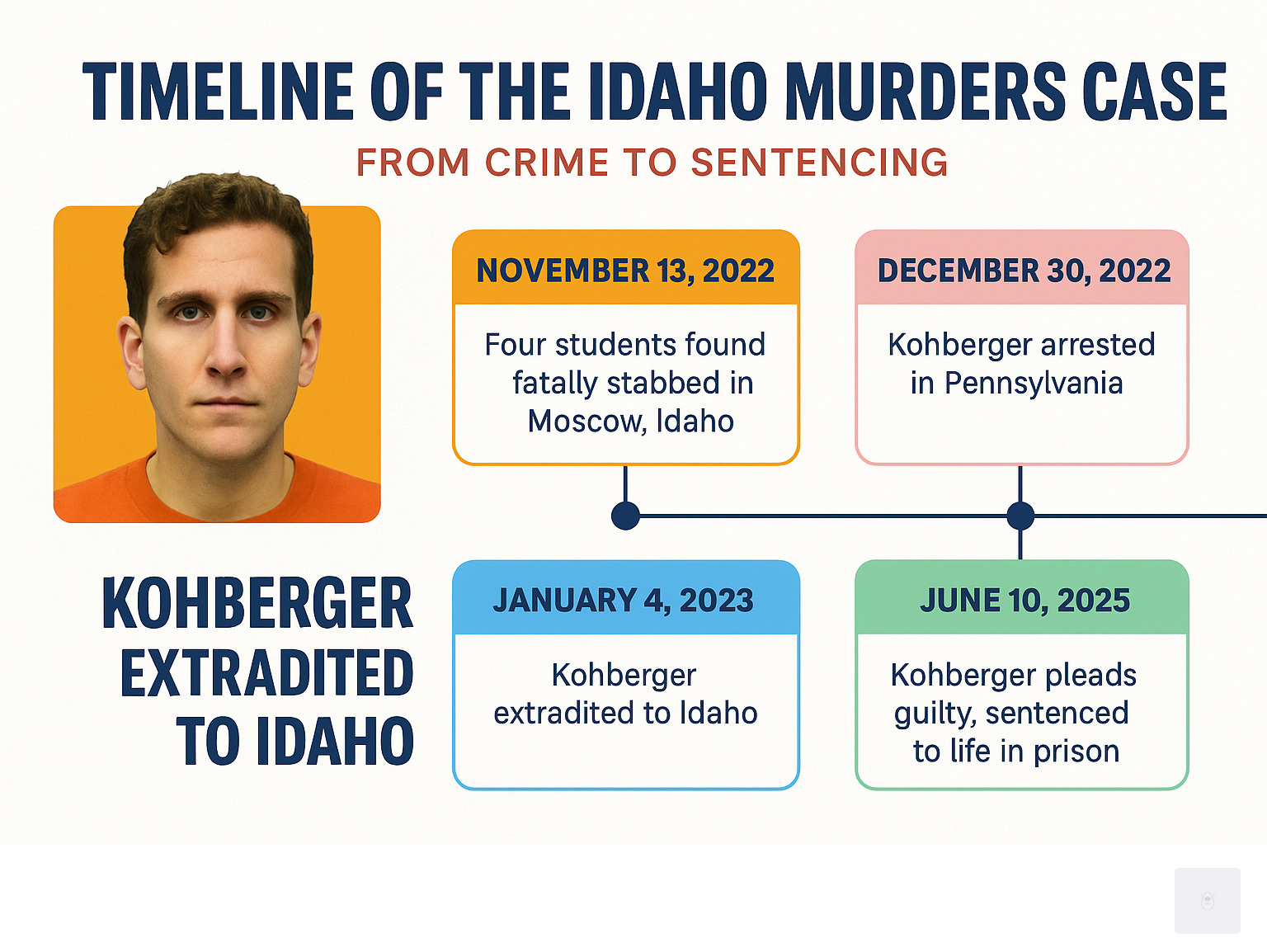
The Bryan Kohberger Case: What You Need to Know

When you search for Bryan Kohberger, you’re likely looking for answers about one of the most shocking criminal cases in recent memory.
Here’s a quick overview of what he’s known for:
- Bryan Kohberger was convicted of murdering four University of Idaho students: Kaylee Goncalves, Madison Mogen, Xana Kernodle, and Ethan Chapin.
- He received four consecutive life sentences.
- He pleaded guilty to avoid the death penalty.
- The motive for the killings remains unknown to the public.
The name Bryan Kohberger became infamous following the tragic 2022 murders of four University of Idaho students. This brutal crime captured national attention, sparking intense public interest and a massive investigation. Here in New York City, a place that has seen its own share of high-profile crimes, the details were particularly shocking and bewildering.
Kohberger, a criminology PhD student, was eventually identified and arrested. But even with a conviction, many questions still linger. As Judge Steven Hippler stated during Kohberger’s sentencing, he was a “faceless coward,” a sentiment that reflects the immense public and judicial frustration with the lack of a known motive.
As R. Couri Hay, I’ve closely followed high-profile cases like Bryan Kohberger’s from my base in New York City, observing the intersection of legal proceedings and public interest. My career in public relations has given me a unique perspective on how such stories unfold in the media.
Below is a timeline of the key events in this complex case.

Also Read: A Comprehensive Guide to the Idaho College Murders
Who is Bryan Kohberger? The Criminology Student Behind the Crime
Understanding who Bryan Kohberger was before the murders reveals a deeply unsettling irony, a topic of much discussion in circles from New York City to the Pacific Northwest. This man who would commit one of Idaho’s most horrific crimes was actually studying the very field that seeks to understand criminal behavior.
Bryan Kohberger grew up in Pennsylvania and seemed to follow a traditional academic path. He earned his psychology degree from DeSales University before pursuing what many would consider a prestigious opportunity – a PhD in criminology at Washington State University.
The location of his studies adds another chilling layer to this story. Washington State University sits less than eight miles from Moscow, Idaho – the very place where Bryan Kohberger would later commit his crimes. For someone studying criminology, he was practically living next door to his future victims.
But his academic career wasn’t going smoothly. Bryan Kohberger worked as a teaching assistant at WSU, but behavioral issues soon emerged. A fellow teaching assistant, known only as ‘L’ in court documents, described him as intelligent but selfish. More troubling were reports of inappropriate interactions with female students.
These behavioral problems eventually cost him his job. The university fired Bryan Kohberger from his teaching assistant position, though the exact details remain somewhat unclear.
During legal proceedings, we learned more about his personal struggles. Bryan Kohberger had been diagnosed with both obsessive-compulsive disorder and autism spectrum disorder. While these conditions help explain some of his unusual behaviors, they certainly don’t excuse the horrific acts that followed.
Bryan Kohberger’s Behavior Before and After the Murders
The time around the murders revealed disturbing patterns in Bryan Kohberger‘s behavior that investigators couldn’t ignore, details that were dissected in news reports and conversations across the country, including here in New York.
After the killings, people noticed physical signs that something was wrong. Bryan Kohberger had visible scratches on his face and wounded knuckles. When asked about these injuries, he claimed they came from a car accident. Looking back, this explanation seems highly suspicious.
Investigators also observed him obsessively cleaning his white Hyundai Elantra – the same car that surveillance footage would later place near the crime scene. Even more telling, he was seen wearing surgical gloves and carefully placing his trash in zip-lock bags, behavior that suggested someone desperately trying to eliminate evidence.
Once Bryan Kohberger was arrested and jailed, his strange habits continued. Fellow inmates described him as “weird” and noted his extreme cleanliness routines. He would shower for 45 minutes to an hour every day and wash his hands dozens of times daily.
His sleep schedule was also unusual. Bryan Kohberger stayed awake most nights, then napped during the day. He spent hours each day video chatting with his mother, clearly leaning on her for emotional support during this difficult time.
While generally polite to other inmates, he did lose his temper once when he thought someone made a comment about his mother. These behaviors in jail, combined with the intense public scrutiny of the case, highlight the complex challenges of managing such a high-profile situation. For more on navigating difficult public perceptions, you might find information about crisis management pr services helpful.
Chilling Interactions and Digital Footprints
Perhaps the most disturbing insights into Bryan Kohberger‘s mindset came from his digital activities and personal interactions before the murders. The digital trail he left behind became a key part of the narrative that captivated audiences in New York and beyond.
A woman who matched with him on Tinder later recalled a deeply unsettling conversation. Bryan Kohberger had asked her about the worst way to die – a topic that seems innocent enough until you consider what he would later do. Even more chilling, he specifically asked her about “Ka-Bar” knives, the exact type of military-style weapon investigators believe was used in the murders.
His Amazon search history told an equally disturbing story. When investigators obtained a warrant for his account, they found evidence of his interest in knives and related accessories. They could see not just what he bought, but what he added and removed from his shopping cart – providing a window into his planning process.
But the most damning evidence came from his cell phone data. Between June 2022 and November 13 (the night of the murders), Bryan Kohberger‘s phone pinged from cell towers near the victims’ home at least twelve times. This wasn’t coincidence – it was a clear pattern of stalking behavior.
Investigators also finded that Bryan Kohberger had tried to wipe many of his electronic devices before they could examine them. This obvious attempt to destroy evidence showed he understood exactly what he had done and was trying to cover his tracks.
These digital breadcrumbs played a crucial role in building the case against him. The way such information comes to light in criminal investigations shows how important data has become in modern law enforcement. For those interested in how complex information reaches the public, understanding publicity services in a broader context might offer some insight into information dissemination.
The Idaho Murders: A Night of Terror and New Revelations
The quiet college town of Moscow, Idaho, was forever changed on the night of November 13, 2022. Four bright University of Idaho students—Kaylee Goncalves (21), Madison Mogen (21), Xana Kernodle (20), and Ethan Chapin (20)—were brutally murdered in their off-campus home at 1122 King Road.

This horrific crime sent shockwaves across the nation. Even here in New York City, we found ourselves glued to news updates, trying to make sense of such senseless violence. The case immediately captured national attention, leaving everyone searching for answers about what could drive someone to commit such brutal acts.
After Bryan Kohberger‘s sentencing, over 300 documents related to the case were unsealed by the Moscow Police Department. These revelations lifted the veil on some of the most disturbing details of that terrible night. The documents painted a grim picture of the extreme violence that unfolded in the early morning hours, revealing just how brutal the attack truly was.
The Crime Scene and Victims’ Injuries
The details that emerged from the unsealed documents were nothing short of heartbreaking, sending a new wave of shock through communities like ours in New York City. The sheer brutality of the attack became clear as investigators revealed the extent of the victims’ injuries.
Xana Kernodle suffered the most extensive injuries, stabbed more than 50 times. Many of her wounds were defensive, showing she fought desperately for her life. The evidence suggested an intense struggle had taken place, with Xana clearly trying to protect herself and possibly others.
Kaylee Goncalves sustained injuries so severe that her face was described as “disfigured” and “unrecognizable.” Madison Mogen also suffered multiple stab wounds. While investigators believe the victims were likely asleep when the attack began, the defensive wounds tell a story of courage in the face of unimaginable terror.
The crime scene itself revealed disturbing details. Investigators found an open back patio door, footprints in the snow, and a black backpack in the backyard. Importantly, autopsy findings confirmed there was no sexual assault, ruling out that potential motive.
These horrific details underscore the random, senseless nature of the violence. For those seeking official information about the case, you can access court documents in the Kohberger case to understand the legal specifics.
The Surviving Roommates’ Eyewitness Accounts
Two roommates, Dylan Mortensen and Bethany Funke, survived that terrible night. Their accounts became crucial pieces of the puzzle, though they also faced intense public scrutiny for their delayed response—a phenomenon well-understood in the media landscape of New York.
Bethany Funke initially thought the commotion was just a “firecracker” or saw what looked like a “sparkler” through her door. Like many college students might, she even wondered if it was some kind of fraternity joke—a tragically innocent assumption.
Dylan Mortensen heard something more disturbing. She heard crying and an unfamiliar male voice saying “There’s someone here.” When she peered out her door, she saw something that would haunt her forever: a masked man in black with bushy eyebrows walking toward the back door.
In a moment that gripped public attention, Dylan made direct eye contact with the suspect. The terror of that moment is difficult to imagine. She later described being in a state of frozen shock, unable to process what she was witnessing.
The most controversial aspect of the roommates’ experience was the delayed 911 call. The call reporting an “unconscious person” wasn’t made until over seven hours after the murders occurred. Dylan later explained she was “intoxicated and didn’t want to believe what was going on.”
While this delay sparked intense public debate, it’s important to remember the profound shock and disbelief that would paralyze anyone in such a terrifying situation. The human mind often struggles to accept unimaginable horror, especially when you’re a young person who should feel safe in your own home.
The Manhunt: How Investigators Tracked Down a Killer
The brutal murders at 1122 King Road sparked what would become one of the most intensive manhunts in recent memory. From my perspective here in New York City, watching this unfold was both fascinating and terrifying—the sheer scale of the investigation was unlike anything we’d seen in years.

The investigation brought together a massive team of law enforcement agencies. The Moscow Police, Idaho State Police, and FBI worked around the clock, creating a collaborative effort that stretched across state lines. The public response was overwhelming—by December 24, just over a month after the murders, investigators had received more than 15,000 tips from concerned citizens across the country.
For more than six weeks, the case captivated the nation. Every news outlet, including those of us following from New York, was tracking every development. The breakthrough came when investigators identified a white Hyundai Elantra spotted near the crime scene. This vehicle became the golden thread that would eventually lead them to Bryan Kohberger.
The manhunt took investigators on a cross-country chase. Bryan Kohberger had driven from Washington State to his parents’ home in Pennsylvania, seemingly unaware that law enforcement was closing in. During his journey, he was pulled over twice in Indiana for minor traffic violations—routine stops that, in hindsight, show just how close investigators were to their target.
The use of genetic genealogy played a crucial role in the investigation, helping to narrow down potential suspects through DNA analysis. This modern investigative technique, combined with traditional police work, created a web that Bryan Kohberger couldn’t escape.
Key Evidence That Led to the Arrest
The case against Bryan Kohberger was built on multiple pieces of compelling evidence that investigators carefully gathered over weeks of intensive work, a process followed closely by legal experts and the public in New York City. The DNA on a knife sheath found at the crime scene proved to be the most damning evidence. This tan leather sheath contained male DNA that statistically matched Kohberger’s profile, obtained from a discarded Q-tip found in his parents’ trash.
The white Hyundai Elantra surveillance footage became another cornerstone of the case. Multiple cameras captured a vehicle matching Kohberger’s car near the victims’ home around the time of the murders. This visual evidence helped establish his presence at the scene.
Perhaps most chilling was the cell phone data triangulation that revealed Bryan Kohberger‘s phone had pinged from towers near the victims’ residence at least twelve times between June 2022 and the night of the murders. This digital footprint suggested a disturbing pattern of stalking behavior.
Investigators also uncovered online shopping records showing that Kohberger had purchased a military-style Ka-Bar knife, sheath, and sharpener eight months before the homicides. The timing of these purchases would later seem far from coincidental.
The public tips proved invaluable, with over 15,000 pieces of information flooding in from concerned citizens. One particularly helpful tip came from a Walmart employee who reported a man looking for a black ski mask—details that would later fit the suspect description.
Finally, vehicle tracking and subpoenas helped investigators piece together Kohberger’s movements and digital activity. Law enforcement even issued subpoenas for information from dating platforms like Tinder, following every possible lead in their determination to solve this case.
This combination of traditional detective work, modern technology, and public cooperation created an investigative net that ultimately led to Bryan Kohberger‘s arrest at his parents’ Pennsylvania home.
From Courtroom to Prison: The Legal Saga and Final Sentence
After his arrest in Pennsylvania, Bryan Kohberger faced the complex process of extradition back to Idaho. The legal wheels began turning quickly once he arrived, with a grand jury handing down an indictment in May 2023. The charges were severe: four counts of first-degree murder and one count of felony burglary.
The case had already captured massive media attention across the country, including here in New York City where many of us followed every development. This intense publicity raised serious concerns about whether Bryan Kohberger could receive a fair trial in Moscow, Idaho, where the community was still reeling from the tragedy.
Legal experts debated a possible change of venue, understanding that finding impartial jurors in a small college town would be nearly impossible. The case had become a national obsession, with details discussed in coffee shops and newsrooms from coast to coast.
Bryan Kohberger‘s legal team faced an uphill battle. They had consistently opposed the death penalty as “cruel and unusual punishment,” focusing on what they called the “fine print” of capital punishment laws. This strategic approach would prove crucial in the eventual plea negotiations.
The turning point came when Bryan Kohberger entered a plea deal, admitting guilt to all charges. This decision allowed him to avoid the death penalty, which had been a real possibility given the heinous nature of the crimes. For legal teams navigating such complex cases, strategic planning becomes essential – much like how defense attorneys must carefully plan their approach. Understanding strategic planning services can show how foresight shapes critical outcomes.
The Sentencing of Bryan Kohberger
The sentencing hearing was a day of raw emotion and long-awaited justice, with news outlets from New York to Idaho broadcasting the outcome. Bryan Kohberger, then 30 years old, sat quietly in the courtroom as Judge Steven Hippler prepared to deliver the sentence that would seal his fate.
When given the opportunity to speak, Bryan Kohberger declined. His silence left a courtroom full of grieving families without the answers they desperately sought. No explanation. No apology. No insight into why four innocent lives were taken.
Judge Steven Hippler didn’t hold back in his remarks. He called Bryan Kohberger a “faceless coward” and made it clear that there was “no reason for these crimes that could approach anything resembling rationality.” The judge’s words carried the weight of a community’s anger and bewilderment.
The sentence was severe but expected: four consecutive life sentences without the possibility of parole for the murders, plus an additional 10 years for the burglary count. Bryan Kohberger would never walk free again.
The victims’ families delivered powerful impact statements that brought many to tears. Alivea Goncalves, Kaylee’s sister, didn’t mince words, calling Bryan Kohberger a “sociopath, psychopath, murderer.” Her statement earned applause from the packed courtroom.
Cara Kernodle, Xana’s mother, expressed the frustration many felt: “It was too easy for him to just admit that he did it and not give an explanation or answer our questions.” The lack of a clear motive continued to haunt the families and the public.
Not all families felt the same way about the plea deal, though. Stacy Chapin, Ethan’s mother, offered a different perspective: “For us, we always felt like this was a better deal. He gets put away.” Her words reflected the complex emotions surrounding justice and closure.
Judge Hippler ended with a powerful observation about the case’s public fascination. He suggested that “by continuing to focus on the why, we continue to give Mr. Kohberger relevance, we give him agency and we give him power.” The judge felt it was time to end “Mr. Kohberger’s 15 minutes of fame” and shift focus back to the victims and their lasting legacy.
Frequently Asked Questions about the Bryan Kohberger Case
As someone who has followed countless high-profile cases from here in New York City, I know how complex stories like Bryan Kohberger‘s can leave readers with lingering questions. The sheer brutality of this case, combined with its many unanswered elements, has sparked intense curiosity nationwide.
Let me address the most common questions I’ve encountered about this tragic case.
What was Bryan Kohberger’s sentence?
Bryan Kohberger received four consecutive life sentences without the possibility of parole for murdering Kaylee Goncalves, Madison Mogen, Xana Kernodle, and Ethan Chapin. The judge also added a 10-year fixed sentence for the felony burglary charge.
This sentencing came as part of a plea agreement where Kohberger pleaded guilty to avoid facing the death penalty. At 30 years old, he will spend the rest of his life behind bars with no chance of ever being released.
The plea deal sparked mixed reactions from the victims’ families. While some, like Ethan’s mother Stacy Chapin, felt it was “a better deal” that ensured he’d be “put away,” others wanted him to face the ultimate punishment.
What was the key piece of evidence against Bryan Kohberger?
The DNA evidence was absolutely crucial in this case. Investigators found male DNA on a tan leather knife sheath left at the crime scene, which became the smoking gun that led to Kohberger’s arrest.
Here’s how it unfolded: Police obtained Bryan Kohberger‘s DNA from a discarded Q-tip found in his father’s trash. When lab results came back, they showed a statistical match to the DNA on the knife sheath. This forensic link directly connected him to the scene of the murders.
While three other unidentified male DNA samples were also found at the crime scene (which the defense later argued could clear Kohberger), it was this knife sheath DNA that proved most damning. Without this evidence, the case against him would have been much more difficult to prove.
Did Bryan Kohberger ever reveal his motive?
This remains one of the most frustrating aspects of the entire case. Bryan Kohberger has never publicly revealed why he committed these murders. When given the opportunity to speak at his sentencing hearing, he declined to say anything at all.
Even more puzzling, investigators found no clear connection between Kohberger and his victims. As Moscow Police Cpl. Brett Payne explained, “Trust us, we wanted that to be the case. We’ve looked for a link, and we have not found one.”
The lack of motive continues to haunt the victims’ families. Cara Kernodle, Xana’s mother, expressed her frustration during sentencing, saying it was “too easy for him to just admit that he did it and not give an explanation or answer our questions.”
Judge Steven Hippler seemed to suggest that focusing on the “why” only gives Kohberger more attention and power. Still, for those of us following the case, the absence of a clear motive makes this tragedy even more senseless and disturbing.
Conclusion
The Bryan Kohberger case stands as one of the most shocking and perplexing criminal cases of our time. The brutal murders of four young University of Idaho students—Kaylee Goncalves, Madison Mogen, Xana Kernodle, and Ethan Chapin—sent shockwaves far beyond Moscow, Idaho, reaching all of us here in New York City and across the nation.
What makes this case particularly haunting is not just the violence itself, but the complete absence of answers to the most fundamental question: why? Despite months of investigation, court proceedings, and Bryan Kohberger‘s eventual guilty plea, we still don’t know what drove a criminology PhD student to commit such horrific acts against four strangers.
The investigation itself was a masterclass in modern police work. From DNA evidence on a knife sheath to cell phone pings that tracked Kohberger’s movements, investigators pieced together a complex puzzle that spanned multiple states. The 15,000+ tips from the public showed how deeply this case resonated with people everywhere.
Yet even with all the evidence and a life sentence handed down, the unanswered questions continue to gnaw at us. As Judge Steven Hippler noted during sentencing, there was “no reason for these crimes that could approach anything resembling rationality.” Perhaps that’s the most unsettling truth of all—that sometimes there simply are no satisfying answers to incomprehensible evil.
The public fascination with this case reflects something deeper about our collective need to understand the inexplicable. From our perspective here in New York, we’ve watched this story unfold with the same mixture of horror and bewilderment that has gripped the entire country.
At R. Couri Hay Columns, we believe in examining the stories that shape our culture, even the most difficult ones. While this case may be closed legally, its impact on how we think about safety, justice, and the mysteries of human nature will likely continue for years to come.
For more insights into the stories that matter and more info about our services, we invite you to explore what we do at R. Couri Hay Columns.

